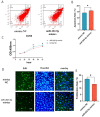miR-450-5p and miR-202-5p Synergistically Regulate Follicle Development in Black Goat
- PMID: 36613843
- PMCID: PMC9820456
- DOI: 10.3390/ijms24010401
miR-450-5p and miR-202-5p Synergistically Regulate Follicle Development in Black Goat
Abstract
Follicle maturation is a complex biological process governed by numerous factors, and researchers have observed follicle development by studying the proliferation and apoptosis of follicular granulosa cells (GCs). However, the regulatory mechanisms of GCs proliferation and death during follicle development are largely unknown. To investigate the regulatory mechanisms of lncRNAs, mRNAs, and microRNAs, RNA sequencing (RNA-seq) and small RNA-seq were performed on large (>10 mm) and small follicles (<3 mm) of Leizhou black goat during estrus. We discovered two microRNAs, miR-450-5p and miR-202-5p, which can target GCs in goats and may be involved in follicle maturation, and the effects of miR-450-5p and miR-202-5p on ovarian granulosa cell lines were investigated (KGN). Using cell counting kit-8 (CCK-8) assays, 5-Ethynyl-2’-deoxyuridine (EdU) assay and flow cytometry, miR-202-5p overexpression could suppress the proliferation and induce apoptosis of GCs, whereas miR-450-5p overexpression induced the opposite effects. The dual-luciferase reporter assay confirmed that miR-450-5p could directly target the BMF gene (a BCL2 modifying factor), and miR-202-5p targeted the BCL2 gene. A considerable rise in phosphorylated Akt (p-AKT) protein was observed following the downregulation of BMF by miR-450-5p mimics. After BMF gene RNAi therapy, a notable elevation in p-AKT was detected. Mimics of miR-202-5p inhibited BCL2 protein expression, significantly decreasing p-AMPK protein expression. These results imply that during the follicular development in black goats, the miR-450-5p-BMF axis favored GC proliferation on a wide scale, while the miR-202-5p-BCL2 axis triggered GC apoptosis.
Keywords: MiR-202-5p; MiR-450-5p; follicle development; goat; granulosa cells.
Conflict of interest statement
The authors declare no conflict of interest.
Figures








References
MeSH terms
Substances
Grants and funding
LinkOut - more resources
Full Text Sources
Other Literature Sources
Miscellaneous

